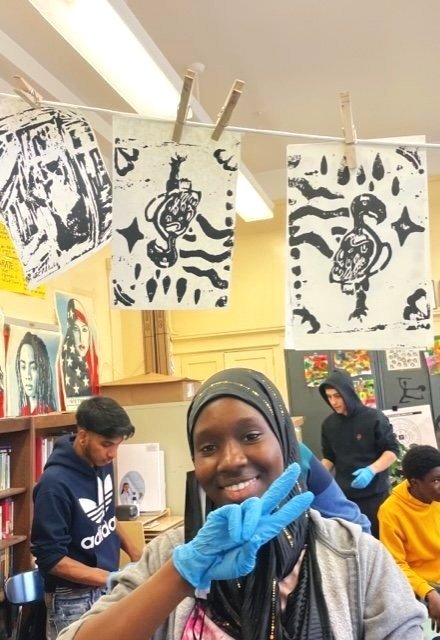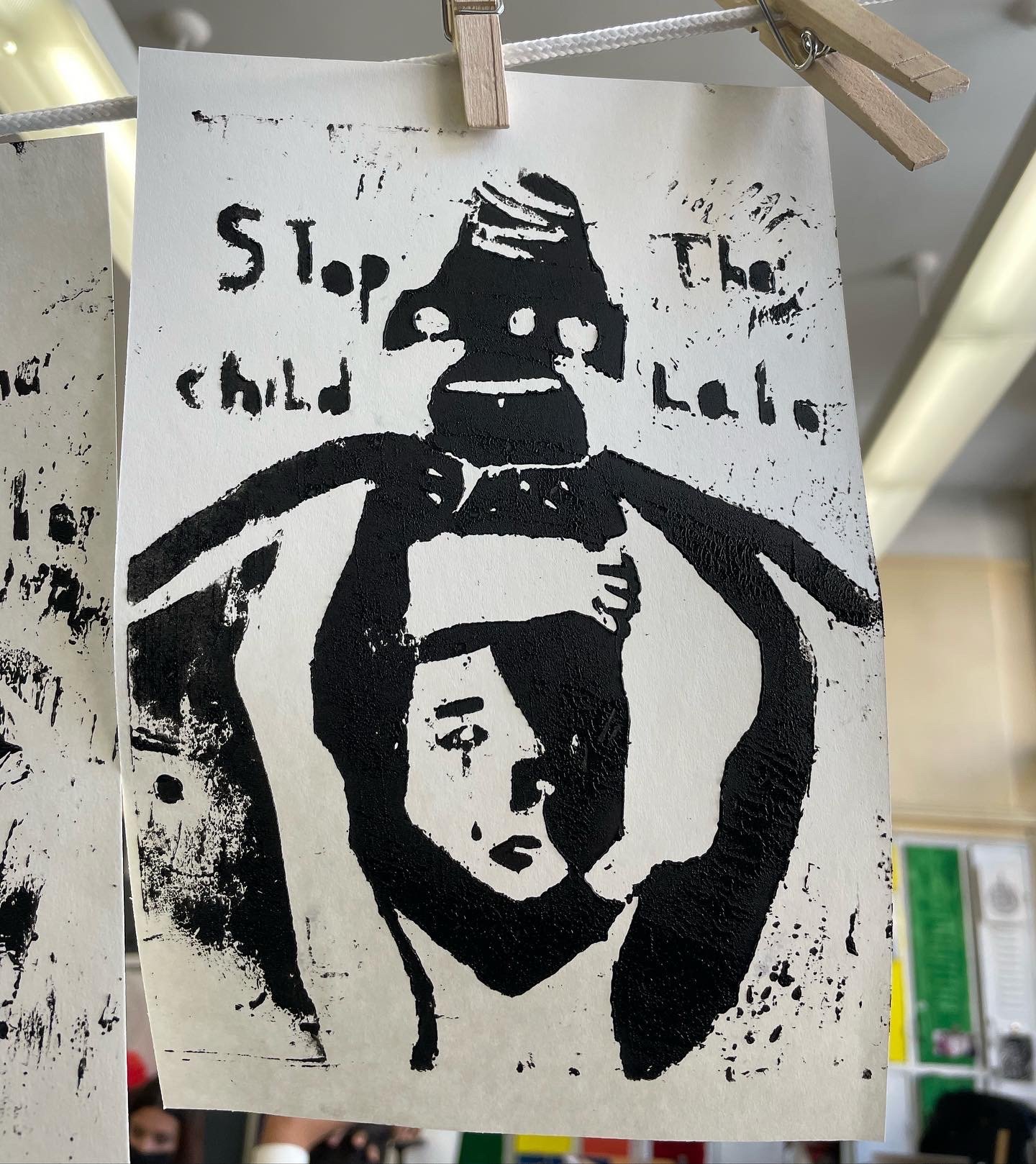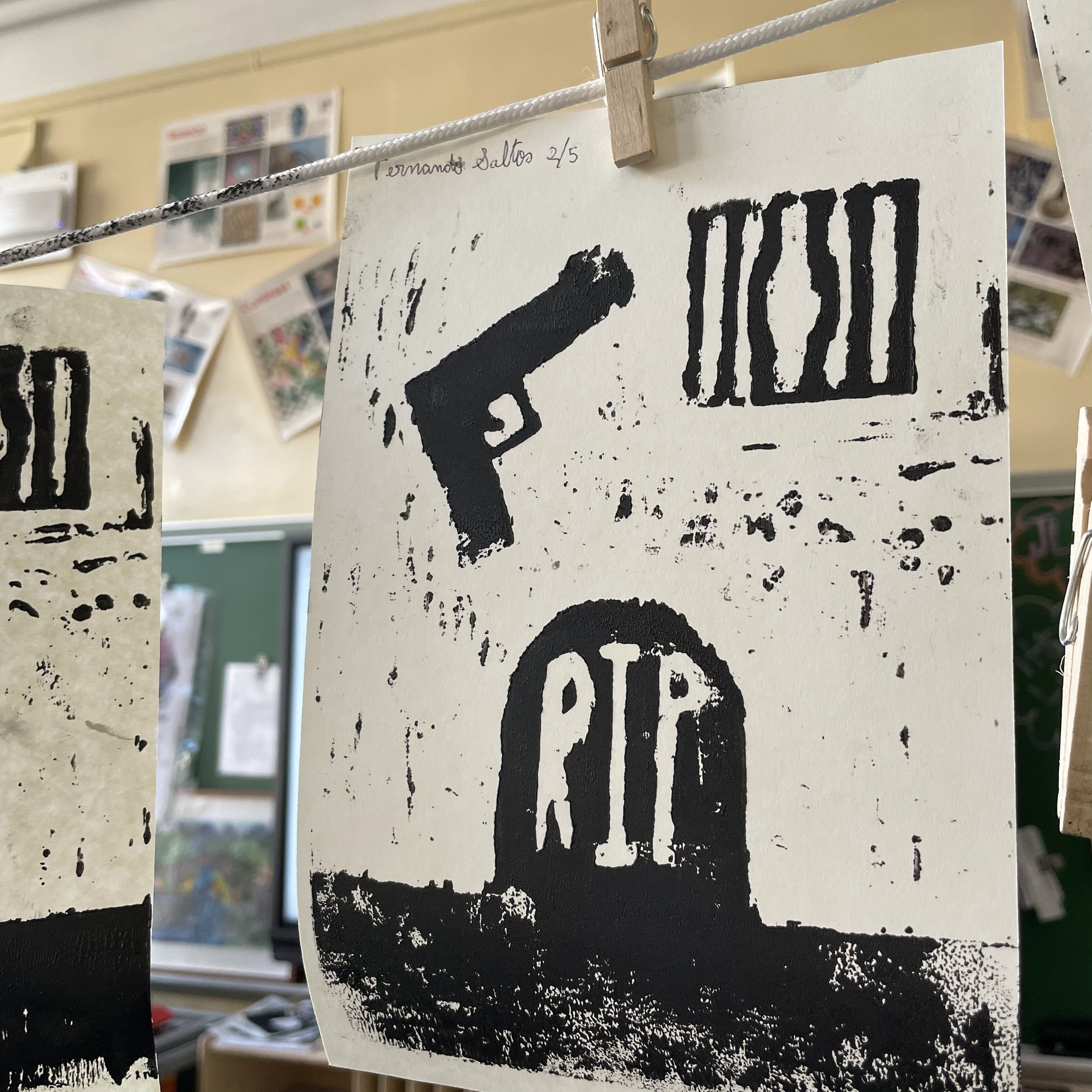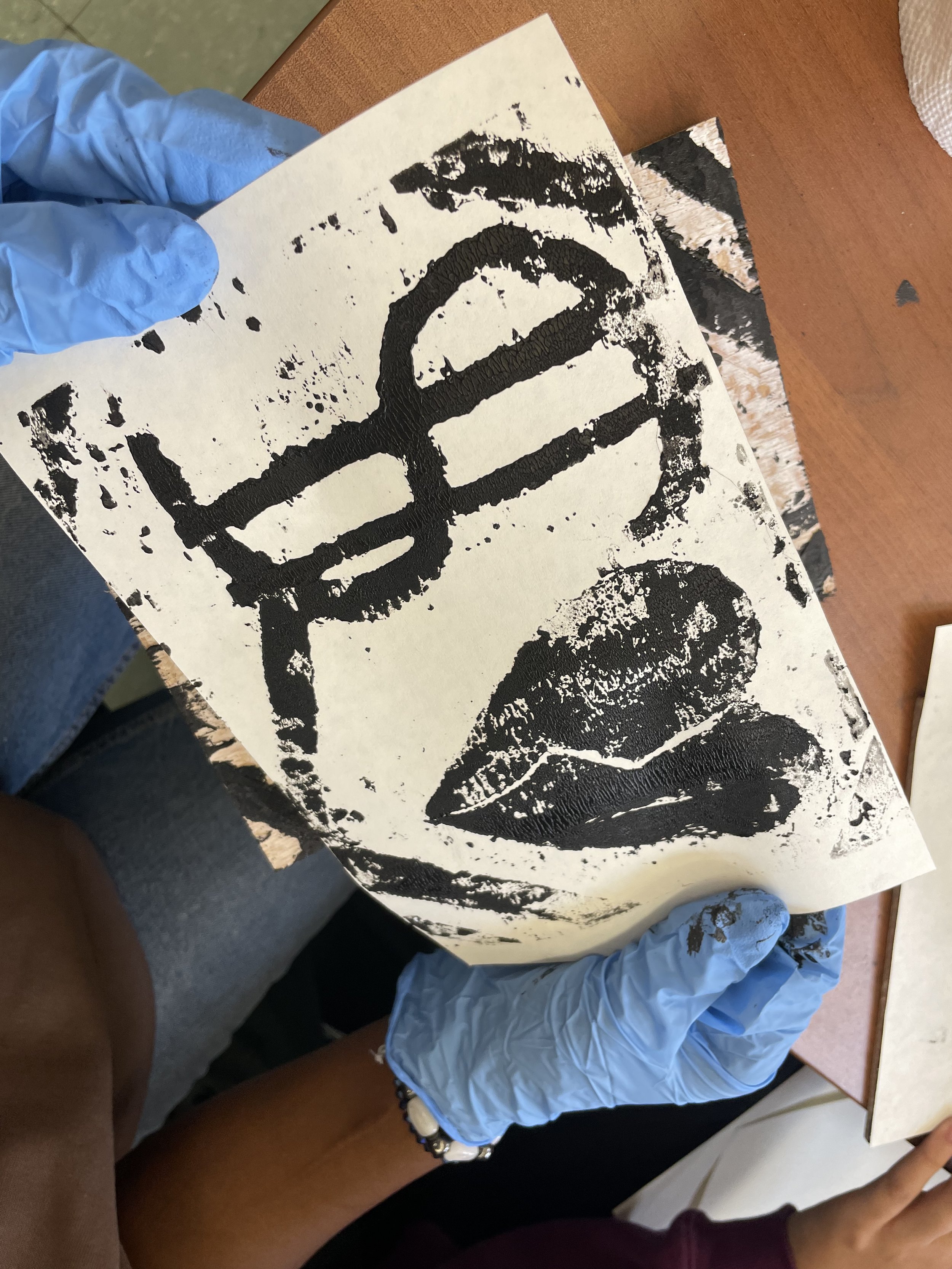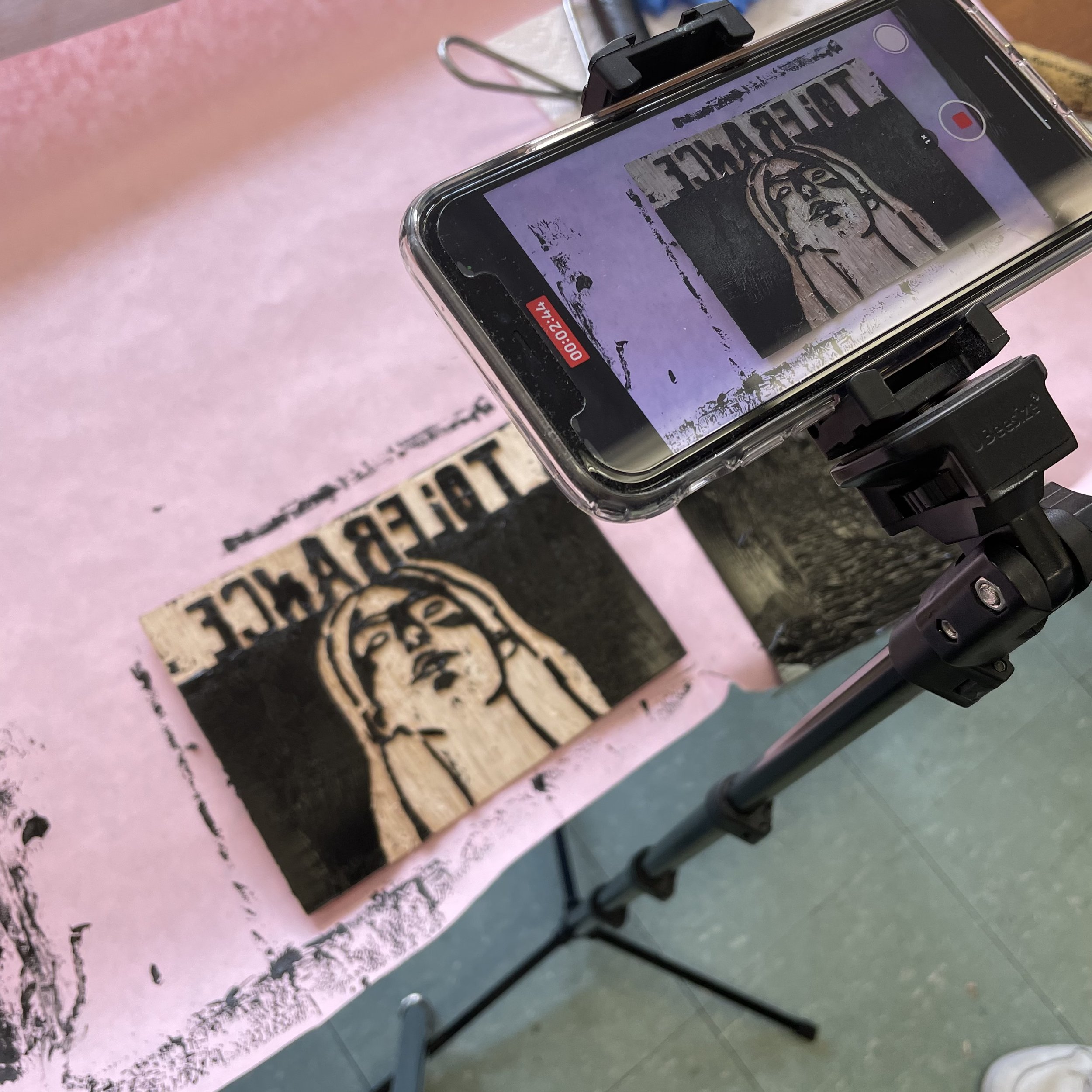Show me your story
Show Me Your Story: Amplifying Underreported Stories through Printmaking. In this unit, with the support from the Pulitzer Center Teacher Fellowship, New York City multilingual learning high school students encountered and read about global issues where art is a vehicle to share underreported stories. Uncovering news outside of mainstream media through the visual arts develops media literacy skills and allows another means for students to have a powerful and just voice to share news. The visual arts contribute to society by communicating the news to multilingual classrooms, homes and communities. This growth mindset for a more empathetic and collective voice to amplify the lives of others can create a better listener of each person too.
-

understand
Through this art project based unit MLL students in New York City explored news stories supported by the Pulitzer Center and witnessed how the visual arts is globally used to communicate underreported stories. MLL students can benefit from using art as a vehicle for communication, as it is a fluid language spoken by all. 4 Pulitzer Center supported news reports were explored together. Vik Muniz Wasteland and JR & Agnes Varda’s Faces Places were viewed in class as an example of empathy in motion. Lessons were supplemented with an introduction to contemporary artists, such as Jordan Casteel, who use their work to tell stories of underrepresented individuals and groups. During each class students engaged in class discussions in various ways including small groups, graphic organizers, and catching notes in their sketchbooks.
-

create
Looking at examples of Pulitzer Center’s supported news stories and how artists interpret and share global issues, students began adapting and creating their own visual response. After research, reading, and sharing news stories, students created a woodblock print focusing their visual art skills to tell a story. Their stories are of people, flora and fauna, crisis and celebration- global voices that deserve to be amplified.
-
Share
As students created their prints they were also asked to film their work in progress (similar to a journal). These videos include dialogue explaining the artistic process, some videos conclude with a conversation with a viewer outside of class. The conversations record reactions to both the print and the underreported story. This video is a documentation of their success in sharing underreported news and helping to create a more empathetic and curious world.
An Introduction
A student created video introduces you to our project!
From our students
Watch this!
A component of our project, Show Me Your Story: Amplifying Underreported News Stories, students created videos documenting their experience start to finish. Below is a video from a student’s point of view.
STUDENTS AT WORK
This project began with initial research individually and quickly unfolded into a collaborative project. The experiential learning project gave each student hands on opportunities to responsibly work in groups. The unit began with developing language skills in the context of the visual world and as a class we applied these skills purposefully into this interdisciplinary project.
Hello! Welcome to art class! Click this picture to go to our classroom Instagram.
We began with first trying to understand: What is an underreported story?
Jamboard was a great way to share our questions and answers with one another. It is good to see that our questions were sometimes the same as our classmates.
Google Classroom is used in our class. All of our articles and information was in one place for us to revisit.
The article on the young artists in Sudan expressing their thoughts on the political state of their country was eye opening. Click the picture to go to the article!
Getting our Jam on! We looked closely at Amplifier.Org an the different campaigns artists support. Click this image to go to Amplifier's website!
So many questions, so much to learn.
See!
We read Flying Kites - A Story of the 2013 California Prison Hunger Strike by the Stanford Graphic Novel Project. Click the picture to read more about the graphic novel.
We learned that stories about people can and should also be considered news.
We were able to respond to one another through comments on Google Classroom.
We were asked all sorts of questions, lots of them began with "Why?" !
Some students began outlining their research. This is about a tragedy of a young boy in Iraq and the justice system that failed his family.
A student takes notes and sketches about the lack of transparency in city planning that uproots a community in Albania. Click this picture to read the article in Albanian!
One student illustrates a harrowing tale of a woman hiding from the Taliban. Click the picture to read the news article.
After researching and finding topics we want to share with our classroom (and the world!) we began sketching our ideas. This image is about the US sanctions on Iraq.
We also care for wildlife and nature. These issues matter globally.
One student reminds us that human rights issues still exist, including child labor.
We began carving our woodblocks. Do you notice that the text in our drawing are backwards?
Carving requires lots of different tools.
Safety first! We use benchbooks to prevent our woodblocks from slipping and tools flying!
We worked together and that made us realize it is not only more fun sometimes, it helps with cleaning at all times!
When you carve woodblocks, the areas you carve remain white. The areas you do not carve gets inked by a brayer.
Tah-dah!
I believe I can fly...!
This story is about a man in Colombia that cares for his community deeply.
An ambitious print tackled beautifully!
To think... before the internet, print was an important resource to share news.
Sketch, Carve, Print- Venezuela!
Simplicity at times speaks the loudest.
After the research, sketching, carving, we created strong and powerful messages.
It is important to understand the symbols that countries use to define themselves.
Art is a powerful tool to help discuss the most difficult of topics.
We learned art does not always show joyful moments.
Many of our stories we shared were about the corruption money and greed cause.
And... some of our news stories were about ecological phenomenons!
The news we shared with one another was a way to share with classmates what matters to me.
Documenting our process not only helped us understand the steps it takes to make a woodblock print, it helped us understand why important issues deserve our time and focus.
Unit Resources
Performance Task(s)
Students are encouraged to research and uplift an individual or group of underrepresented peoples and create a series of woodblock prints. Students will be given the choice of exploring news using the Pulitzer Center site and creating artwork that responds to the individual or people of the topic. Their visual responses can be symbolic or illustrative of the story. Students will create a video that include dialogue explaining the artistic process and conclude their filming with a conversation with a viewer outside of class. The conversation will record reactions to both the print and the underreported story.
Assessment/Evaluation
Graphic organizer: Used for checking understanding of news reports and documentaries: These organizers will be kept in their sketchbooks. Sketchbook share outs: Students will share their printmaking ideas with classmates for verbal feedback Critique graphic organizer: As students present their news stories and prints in small groups this provides a chance for students to give written feedback
NATIONAL COMMON CORE STANDARDS
CCSS.ELA-LITERACY.RI.11-12.1 Cite strong and thorough textual evidence to support analysis of what the text says explicitly as well as inferences drawn from the text, including determining where the text leaves matters uncertain.
CCSS.ELA-LITERACY.RI.11-12.3 Analyze a complex set of ideas or sequence of events and explain how specific individuals, ideas, or events interact and develop over the course of the text.
CCSS.ELA-LITERACY.RI.11-12.7 Integrate and evaluate multiple sources of information presented in different media or formats (e.g., visually, quantitatively) as well as in words in order to address a question or solve a problem.
CCSS.ELA-LITERACY.W.11-12.2 Write informative/explanatory texts to examine and convey complex ideas, concepts, and information clearly and accurately through the effective selection, organization, and analysis of content.
CCSS.ELA-LITERACY.W.11-12.2.B Develop the topic thoroughly by selecting the most significant and relevant facts, extended definitions, concrete details, quotations, or other information and examples appropriate to the audience's knowledge of the topic.
CCSS.ELA-LITERACY.W.11-12.2.D Use precise language, domain-specific vocabulary, and techniques such as metaphor, simile, and analogy to manage the complexity of the topic.
NATIONAL COMMON CORE VISUAL ARTS STANDARDS
Creating
VA:Cr2.1 Investigate: Organize and develop artistic ideas and work.
VA:Cr3.1 Reflect, Refine, Continue:Refine and complete artistic work
Connecting
VA:Cn10.1 Synthesize: Relate and synthesize knowledge and personal experiences to inspire and inform artistic work.
VA:Cn11.1 Relate: Investigate ways that artistic work is influenced by societal, cultural, and historical context and, in turn, how artistic ideas shape cultures past, present, and future.
VA:Cn11.2 Interrelate, Extend: Investigate ways that artistic work is influenced by societal, cultural, and historical context and, in turn, how artistic ideas shape cultures past, present, and future.
Responding
VA:Re8.1 Interpret: Interpret intent and meaning in artistic work.
Presenting
VA:Pr.4.1 Select, Preserve: Select, analyze and interpret artistic work for presentation
VA:Pr6.1 Share, Relate: Convey meaning through the presentation of artistic work

https://www.insideoutproject.net/en/explore/group-action/inside-out-back2school-manhattan-international






